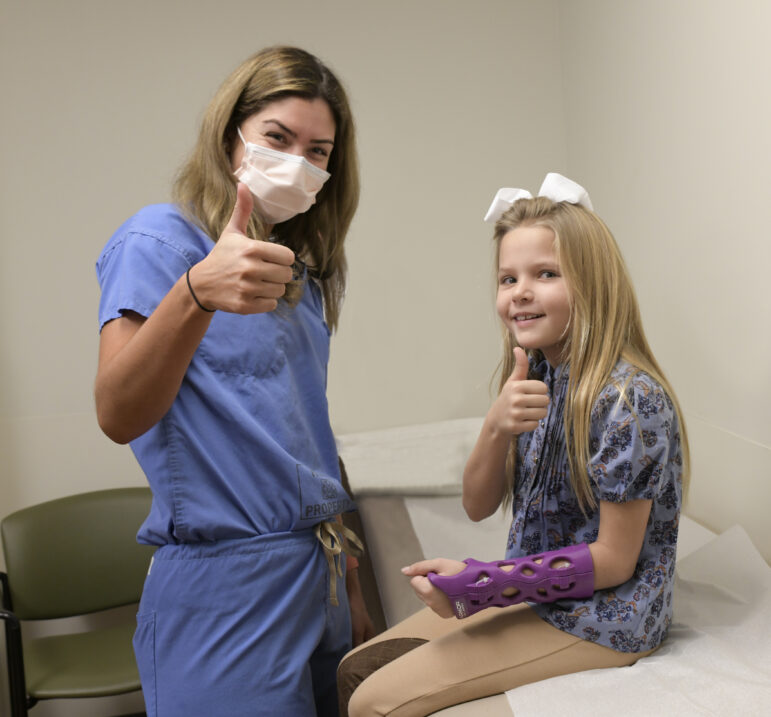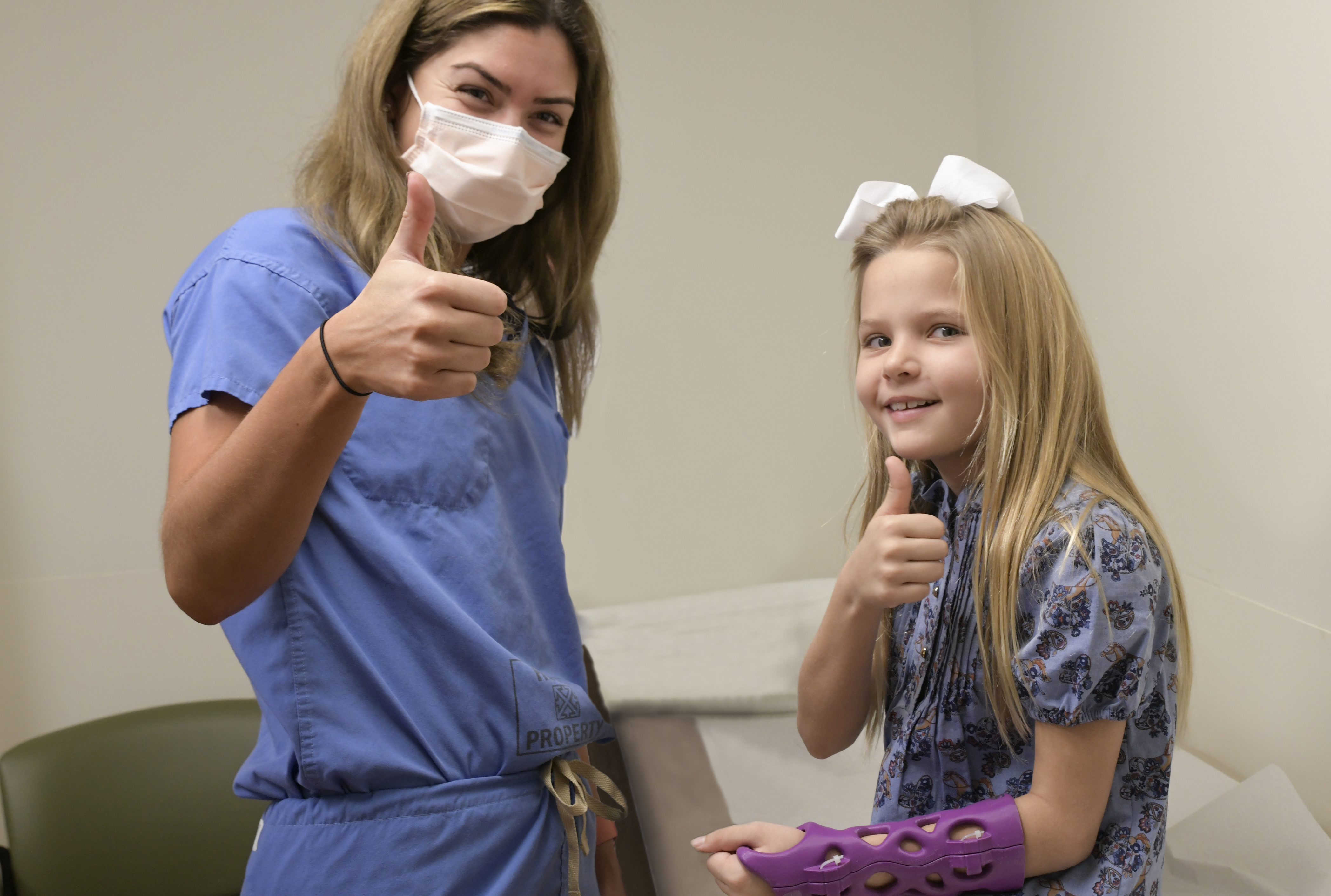
Olivia Balas has her new custom-made ActivArmor cast put on by orthopedic physician assistant Kylie Honnick-Payne. (Credit: St. Luke’s University Health Network)
Anyone who’s ever had to wear a traditional plaster cast during a healing period probably remembers a bulky, heavy and uncomfortable cast wrapped around their skin for weeks or months. Even today’s fiberglass casts can be itchy, trap odors and be difficult to keep clean and dry.
Those days may soon be over thanks to new technology created by ActivArmor of Colorado that creates a removable, waterproof and durable 3-dimensional plastic cast.
The casts have been employed at St. Luke’s Orthopedic Care for more than a year, and in December St. Luke’s became the first health care facility in the nation to use its in-house 3D Print and Innovation Lab to produce ActivArmor casts for upper extremity injuries. The casts are typically covered by medical insurance, including Medicare and Medicaid.
Dustin Greenhill, MD, pediatric orthopedic surgeon at St. Luke’s Orthopedic Care, has been instrumental in deploying this new technology.
“For an active child and their parents, weeks in a cast can feel like months,” he said. “I want them out of a traditional cast as soon as possible, but also need to protect the arm when kids go back to being kids. This cast lets me do both.”
With this new technology, Greenhill said, “we can now get these 3D casts on kids fast–both for stable fractures that simply need to heal and, more recently, unstable injuries. For preadolescents and adolescents with a severe wrist or forearm fracture, I’m now doing their 3D scan during surgery.”
ActivArmor founder and CEO Diana Hall said her company is “excited to work with some of the top innovators in orthopedics at St. Luke’s,” adding that SLUHN’s “reputation for quality, service and patient satisfaction aligns perfectly with our mission at ActivArmor: to improve the safety and quality of life for those requiring immobilization while healing.”
The ability to produce the casts in-house is a game-changer for patients, said Megan Augustine, MS, Network Director of St. Luke’s Simulation Center, which includes the 3D Print and Innovation Lab. Augustine researched and spearheaded the introduction of ActivArmor to St. Luke’s Orthopedics Department by working directly with Hall. After visiting the Colorado-based company and working through hardware and software issues, she was able to bring the technology to SLUHN patients.
“We initially launched a small-scale rollout that allowed us to scan the patient for the cast, upload the file and have it printed by ActivArmor in Colorado and then have it sent to us, which was typically a four-day turnaround,” Augustine said. “I asked Diana to let us know when she was ready to have the 3D printing done onsite, because we wanted to be the first in providing this type of quality care with a quicker turnaround to our patients.”
“We are currently delivering the cast in two business days (and) expect to cut that down to same day delivery in the very near future, which is exactly want our patients want,” she added.
In fact, the ActivArmor option is so popular with patients and parents that many know about it even before they are offered the option, said Kylie Honnick-Payne, a physician assistant who works with Dr. Greenhill. “Some of them heard about it from other kids and they’re asking us for one before we even decide it’s an option,” she said. “The kids just love it.”
The capacity to produce the casts in-house adds an additional layer of convenience.
“Instead of having to wait a week for a custom cast to be made and shipped, we can literally have it in hours,” Honnick-Payne said. “We are starting to scan certain (surgical) patients for it in the operating room, prior to surgery, and have it ready for them when they need it. It is just so much more convenient for the patients and their parents.”
Jessica Kamensky, the service line administrator for Musculoskeletal Services at St. Luke’s, said the patients who are able to experience injury recovery using the ActivArmor casts appreciate its flexibility.
“We found that the younger population, especially, gravitate to them,” she said. “The device can start fastened and then transition to something that is more like a brace that can be easily removed. Kids can play with it on, bathe with it on…it’s just so much more practical than a traditional cast.”
An idea born out of compassion
The idea behind the next-generation casts came to Hall, a former chemical engineer who spent her early career working in software engineering for Fortune 500 companies, through her work with impoverished children. After her daughter was born, she started a mentoring program for children in Pueblo, Colo., and was shocked to see how much of a struggle it was for some children to maintain personal hygiene while wearing traditional casts.
“So many of these children were in sub-standard living conditions to begin with, and then you add an injury, which made circumstances even worse for them,” she said. “I had one young girl who had bed bugs underneath her cast, and a young boy who had a wet cast for four weeks, which led to all kinds of skin issues. I thought there had to be a better alternative to bulky plaster casts. It was archaic. The technology hadn’t really changed for more than a hundred years.”
Drawing on her technological expertise, Hall designed an alternative, created a few prototypes on her 3D printer and shared them with medical professionals. To her delight, the doctors not only approved of the alternative, but also asked for more. Soon she was working directly with the Food & Drug Administration to navigate regulatory requirements.
In 2014, she invested her life savings in the venture, worked with experts at the University of Maryland to develop test protocols and began conducting two years of clinical field tests. By 2017, she was able to bring waterproof, breathable, sanitizable casts that are custom-designed and fitted to each patient to the broader medical market. Today they are used by more than 40 hospitals and fracture care clinics throughout the country as well as the National Football League. ActivArmor casts are also now available in 10 other countries, including the UK, Australia, UAE, Brazil, Greece and South Africa.
To make the cast, a 3D scan is made of the affected appendage and the image is sent to ActivArmor using proprietary software. Now, the St. Luke’s 3D Print and Innovation Lab has the capacity to create two “clamshell-like” halves of the cast, which are then fitted onto the patient’s affected body part. It can be locked on like a cast or removed like a splint to allow swelling of an injured area to subside.
The benefits are abundant. Its lattice-like spacing allows for easier wound care, treatment with advanced healing technologies, and skin care and cleaning. The device can be easily sanitized to remove pathogens, even while it is being worn. The 3D cast can also get wet, and it doesn’t impinge on many activities, including sports. And while not clinically necessary, the “fun” colors that are available make the cast more appealing to both younger and older patients.
It’s also environmentally sustainable, said Augustine, who noted that the plastic is recyclable and 100 percent biocompatible.
Hall said the benefits extend to patients who require voluntary compliance to address issues such as carpal tunnel syndrome.
“With a more comfortable cast, we’re finding patients are using it more frequently, reducing the need for pain medications and allowing for advanced healing technologies, such as muscle stimulation,” she said. “It’s improving healing outcomes for patients quickly and affordably, and giving people their lifestyle freedoms back.”
Note: This local health news is brought to you in partnership with St. Luke’s University Health Network.







